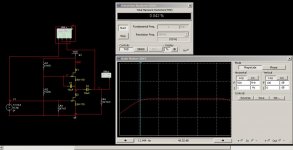Has anyone tried this for a phono or mic pre?
Any thoughts on noise?
Is it better to amplify the small signal from MM/MC first before applying the RIAA eq? or buffer the input signal first then applying the RIAA, then a hi gain circuit? What's better for noise figure?
Thanks.
Sim of the circuit using 2sk170BL's shows THD of 0.042% and a gain of about 51.5db in the pass band with the -3db at 12Hz to 445kHz
Any thoughts on noise?
Is it better to amplify the small signal from MM/MC first before applying the RIAA eq? or buffer the input signal first then applying the RIAA, then a hi gain circuit? What's better for noise figure?
Thanks.
Sim of the circuit using 2sk170BL's shows THD of 0.042% and a gain of about 51.5db in the pass band with the -3db at 12Hz to 445kHz
Attachments
Sorry to dissapoint you but it clips at just over 4mV in and 4mV THD 0,5%.
To work with a MM you should need to have at east 50-80mV before overload.
You will not find much use for that one. Also to be a mu-follower you have to add a resistor between the lower drain and the upper source.
But the concept has a point.
To work with a MM you should need to have at east 50-80mV before overload.
You will not find much use for that one. Also to be a mu-follower you have to add a resistor between the lower drain and the upper source.
But the concept has a point.
Ok,
Would it be enough for a MC? They are in the hundreds of microvolts.
This circuit is from National Semiconductor AN32 notes
http://www.national.com/an/AN/AN-32.pdf
They call it "Ultra-High Gain Audio Amplifier" or "JFET' mu amp''
Thanks🙂
Would it be enough for a MC? They are in the hundreds of microvolts.
This circuit is from National Semiconductor AN32 notes
http://www.national.com/an/AN/AN-32.pdf
They call it "Ultra-High Gain Audio Amplifier" or "JFET' mu amp''
Thanks🙂
- Status
- Not open for further replies.
